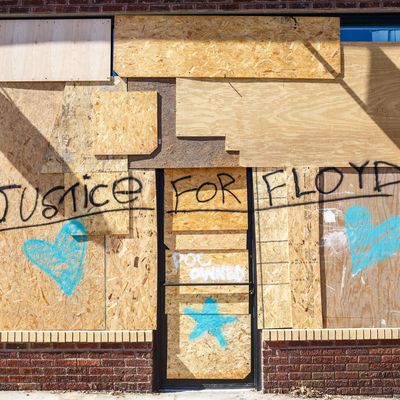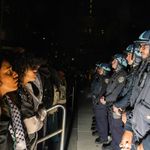
By Valentines Day, the world’s largest economy was out on sick leave. China’s assembly lines lay still, its streets empty, workers idle. The air above Beijing was harrowingly clean. After stalling for a week, Covid-19 cases had just surged by 14,840 in Hubei province. Scientists were warning that the novel coronavirus “not only spreads quickly, but also in ways that are not entirely understood.” Fifteen confirmed cases had surfaced in the U.S.
Five days later, the S&P 500 closed at an all-time high. Apparently, U.S. companies were better off with an uncontained epidemic paralyzing their Chinese operations than they had been months earlier, when the novel coronavirus was still just a twinkle in Satan’s eye. Morgan Stanley assured its clients that markets had nowhere to go but up. After all, the investment bank reasoned, “the pace of infection has slowed” and U.S. equities were “the appropriate asset to own if rates continue to fall so long as we don’t have a recession.”
Four months, $3 trillion in stimulus, and 100,000 U.S. coronavirus deaths later, Wall Street is sanguine once again. The 50 trading days between March 23 and June 3 were the best the S&P 500 has ever seen. A rally that began in tech stocks has spread to frontline sectors, with airlines and hotel chains finding renewed appetite for their shares. As American states reopen their economies, JP Morgan CEO Jamie Dimon has declared that the U.S. boasts “pretty good odds” of a “rapid economic recovery.”
It isn’t that hard to see what Dimon does if you look from the proper vantage (through the window of a private jet, for example): Analysts had expected Friday’s jobs report to show the U.S. economy shedding 7.5 million jobs in May; instead, it showed employers expanding their payrolls by 2.5 million, as the first round of reopenings brought furloughed workers returned to their posts. Meanwhile, personal income in the U.S. rose by a record-high 10.5 percent last month, thanks to stimulus checks and enhanced unemployment benefits. As a result, millions of displaced workers actually gained purchasing power despite their ongoing joblessness. Which means that U.S. consumers are now flush with disposable cash that is sure to flood the economy the minute the pandemic has passed – or, perhaps, before. In reopened states, customers have returned to shopping malls more rapidly than their owners had dared to dream; one chain of shopping centers reported this week that foot traffic is now at 80 percent of pre-pandemic levels at its properties in South Carolina. Meanwhile, demand for air travel is rebounding so strongly, American Airlines just unveiled plans to expand its flight schedule by 74 percent in July. Initial jobless claims are falling. New Covid cases in the U.S. are down by nearly 50 percent since late April. The worst is behind us. Come on in, the Dow Jones is fine.
And yet: listening to the bulls, it’s hard not to think back to those heady days in mid-February, when stock tickers assured us that there was nothing to fear but fear itself. Today, the S&P 500 seems to be asking, once again, “who are you going to believe, me or your lying eyes?”
After all, to the untrained observer, the economic landscape appears studded with eyesores. Twenty-seven major U.S. companies declared bankruptcy in May, the highest monthly total since the Great Recession. Nearly half of all commercial retail rents went unpaid that same month, threatening the solvency of many landlords and sending commercial real-estate prices into freefall. Meanwhile, more than 21 million Americans are collecting unemployment, and analysts warn that a second wave of layoffs – this one, inundating white-collar workplaces – is about to crest. May’s encouraging payroll gains were compromised entirely of workers returning from furlough; permanent job losses actually rose last month. And it’s far from clear that the freshly rehired won’t wash back out of the labor market in short order: Many of these Americans’ owe their resuscitated jobs to the Paycheck Protection Program, which covers the payroll costs of small businesses who rehire their workers or avoid layoffs. American restaurants brought 1.4 million workers back on staff in May. But consumer demand for dining out remains far below its pre-pandemic level. If Congress allows PPP funds to phase out this summer, while demand remains depressed, then permanent job losses could swell.
As for April’s heartening personal income gains, those were wholly attributable to federal transfer payments that congressional Republicans say they won’t extend. When and if enhanced unemployment benefits expire in July, tens of millions of U.S. households will see their spending power diminish, even as the unemployment rate remains above double digits. Which is to say: Even if there were zero risk of a resurgent pandemic or political instability undermining recovery, there would still be cause for economic pessimism.
And of course, there is such risk. For a week now, America’s major cities have played host to nightly bouts of looting and police brutality. As officers of the law assault random bicyclists – while thieves unburden big box stores of their inventories up and down 5th Avenue – it can feel harder to imagine a “V-shaped recovery” than a future resembling V for Vendetta. Add in the potential epidemiological consequences of the (righteous) protests sparked by George Floyd’s killing, and dystopian premonitions grow more plausible. The coronavirus may not spread well outdoors. But hundreds of demonstrators have been arrested and stuffed into poorly ventilated jails and police vans. What’s more, even without a protest-induced spike in infection, the prognosis for America’s pandemic would be less-than-stellar. Daily new coronavirus cases are down from their peak, but they’ve been hovering around a plateau of about 20,000 for weeks. Case counts are still rising in several states and surging in Texas. Maybe those upticks will prove short-lived. Maybe exposure to common cold coronaviruses has rendered a wide swathe of the population invulnerable to Covid-19 (as one recent study suggests is possible). Maybe reopenings will proceed without a hitch, and the release of pent-up demand will thrust beleaguered businesses back into solvency, enabling them to recall sidelined workers just before their federal benefits peter out.
But the case for catastrophism seems at least as credible as the one for optimism. Few have more ably outlined the former than NYU Stern School of Business professor Nouriel Roubini. Renowned for predicting the 2008 crisis, Roubini warns that the world is hurtling towards a full decade of economic depression. The perennially bearish, intermittently prophetic economist argues that the massive private debts accrued during both the 2008 crash and COVID-19 crisis will durably depress consumption and weaken whatever short-lived recovery we happen to muster. Meanwhile, the aging of populations across the West will further undermine growth while increasing the fiscal burdens of states already saddled with hazardous debt loads. As the deepening geopolitical rift between the United States and China triggers a wave of deglobalization, negative supply shocks akin those of the 1970s are going to raise the cost of real resources, just as hyperexploited workers suffer perpetual wage and benefit declines. Stagflation will ensue. And through it all, humanity will be beset by unnatural disasters, from extreme weather events wrought by man-made climate change to pandemics induced by our disruption of ecosystems.
Roubini’s forecast is more hubristic than Jamie Dimon’s (say what you want about the Wall Street bulls, they’re making few claims about the economy’s performance in 2028). Still, the morbid economist’s most audacious near-term predictions have held up oddly well. In an interview with Intelligencer last month, Roubini suggested that “luxury stores in New York” would soon fall prey to “riots,” as a dispossessed underclass raged against an increasingly illegitimate order.
On the other hand, Roubini had expected such looting to derive from inadequate food assistance to cash-strapped households, not police misconduct. The notion that a Minneapolis police officer might kneel on a handcuffed black man’s neck until he died, thereby triggering the broadest anti-racist agitation America had witnessed in half-a-century, did not cross the economist’s mind.
Perhaps then the one wholly unambiguous lesson of the month’s since Morgan Stanley heralded boom times ahead is this: in macroeconomics, as in life, nothing is certain but uncertainty itself. And when one turns from the euphoria on the trading floor – to the disorder in the streets – it’s hard not to conclude that, among investors, uncertainty has become an underappreciated commodity.






























